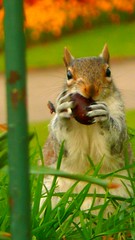 In ordinary autumn, acorns feature prominently at my home and office. Here in Ballston, my apartment is surrounded by big old trees that coat the ground in a crunchy carpet of acorns. And out at my office in Reston, the towering trees at neighboring Lake Fairfax Park deliver a steady bombardment of acorns plummeting through the canopy, then bouncing high off the paved paths (watching it makes you think twice about taking a walk without a helmet).But this year, nothing. And I'm not the only one who's noticed:
In ordinary autumn, acorns feature prominently at my home and office. Here in Ballston, my apartment is surrounded by big old trees that coat the ground in a crunchy carpet of acorns. And out at my office in Reston, the towering trees at neighboring Lake Fairfax Park deliver a steady bombardment of acorns plummeting through the canopy, then bouncing high off the paved paths (watching it makes you think twice about taking a walk without a helmet).But this year, nothing. And I'm not the only one who's noticed:Rachel Tolman, a naturalist at Long Branch, smeared a big glop of peanut butter on one of the nature center's trees. She grabbed handfuls of store-bought hazelnuts and placed them atop boxes to attract the tiny, nocturnal flying squirrels that tend to mass in the oaks every winter. Within seconds, the squirrels dive-bombed in from nearby trees, legs outstretched like fist-size silvery-gray sky divers. "They're so much more willing to be seen this year," Tolman said. "It's because they're so hungry."
Tolman was the first naturalist to notice that there were no acorns or hickory nuts this year. Each fall, starting in September, she takes daily walks through the forest to collect nuts and acorns to feed the flying squirrels and other animals at the center through the winter. This year, she found nothing. "I'm hoping this is just some weird anomaly," she said.
No wonder this little guy was so hungry! Naturalists often discourage directly feeding the critters in your backyard since it makes them dependent on people instead of foraging for themselves. This winter might be an exception.
The article doesn't draw conclusions about why acorns are so scarce this year. Seems that one year without acorns is unusual but not unheard of; however, if it happens again next year, it might be something to worry about.
 A couple of years back, the DC area's wildlife struggled through an acorn shortage, leading to an odd sight on my stoop. But TBD.com reports this year, acorns are mounting a record-breaking comeback:
A couple of years back, the DC area's wildlife struggled through an acorn shortage, leading to an odd sight on my stoop. But TBD.com reports this year, acorns are mounting a record-breaking comeback:
